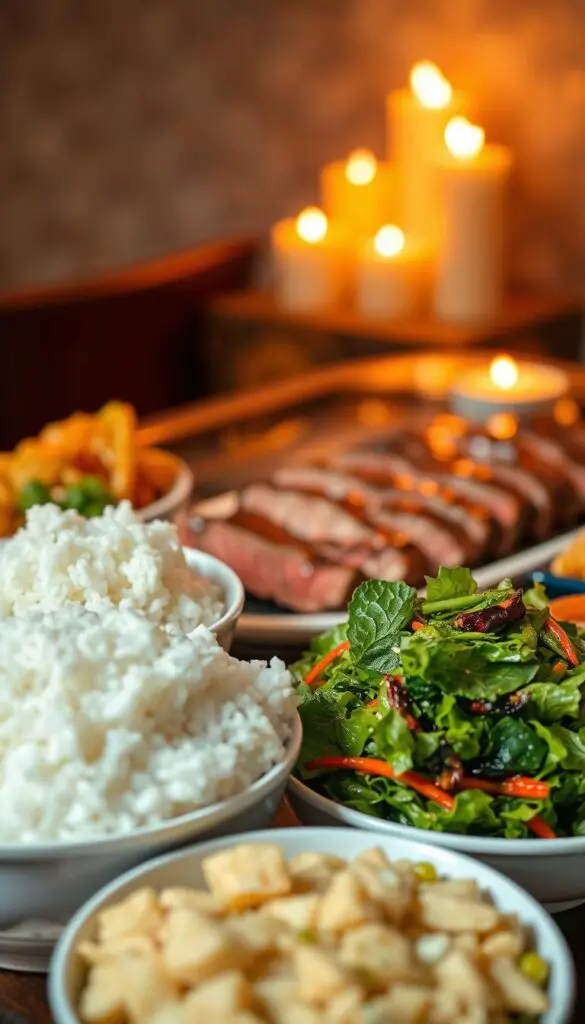Growing up, my family celebrated birthdays with a special hibachi steak dinner at our favorite restaurant. The sizzling sounds, savory aromas, and interactive cooking made every meal unforgettable. Now, I recreate that magic at home with this easy 15-minute recipe.
This dish delivers restaurant-quality flavor without the hassle. Flank steak cooks quickly, while a simple homemade sauce adds depth. Whether using an air fryer or griddle, the results impress every time.
Perfect for busy weeknights, this meal brings everyone together. Kids love watching the preparation, and adults enjoy the bold taste. Pair it with veggies or chicken for a complete dinner experience.
Key Takeaways
- Ready in just 15 minutes for quick weeknight meals
- Tastes better than most local hibachi restaurants
- Works with air fryers, griddles, or traditional pans
- Family-friendly with interactive cooking appeal
- Pairs perfectly with side dishes or other hibachi recipes
Why You’ll Love This Hibachi Steak
Restaurant-quality taste meets weeknight ease in this foolproof recipe. Cubed meat marinates faster than whole cuts, creating a caramelized crust with every sear. High-heat cooking locks in juices, while the soy-mirin blend adds depth.
Save time and money—this version costs half the price of a restaurant meal. The umami-rich sauce balances sweet mirin and savory teriyaki, bursting with flavor from fresh garlic and butter.
- Diet-friendly: Swap regular soy sauce for gluten-free tamari.
- Spice control: Adjust heat with sriracha or chili flakes.
- Meal prep star: Stores well for 3–4 days in the fridge.
Slice against the grain for tender bites every time. Whether you’re hosting or meal prepping, this dish adapts to your needs. Ready in 15 minutes, it’s faster than waiting for delivery.
Ingredients for Hibachi Steak
Great flavor begins with fresh, well-balanced components. I prioritize quality to replicate that iconic restaurant taste. Below, I’ve listed essentials and smart swaps to suit dietary needs.
For the Steak:
- 1.5 lbs strip steak: Balances affordability and rich marbling. For luxury, use ribeye or filet mignon.
- 1 tbsp avocado oil: High smoke point prevents burning. Substitute with grapeseed oil if needed.
- 1 tsp each salt & pepper: Enhances natural meat flavors without overpowering.
For the Sauce:
- ¼ cup low-sodium soy sauce: Controls sodium levels. Use tamari for gluten-free diets.
- 2 tbsp mirin: Adds sweetness. Replace with 1 tbsp rice vinegar + ½ tsp sugar.
- 3 cloves fresh garlic: Minced. Jarred lacks depth—*trust me*, fresh is best.
- 1 tbsp butter or ghee: Ghee handles high heat better for searing.
Pro Tip: Cube the meat evenly for consistent cooking. Thicker pieces stay juicier on the grill.
How to Make Hibachi Steak: Step-by-Step
Mastering this dish requires just three simple steps with big flavor payoffs. Follow these techniques to achieve a caramelized crust and juicy interior every time. I recommend a Lodge cast iron skillet for even heat distribution.
Step 1: Marinate the Steak
Cut 1.5 lbs of meat into 1″ cubes for quick, even cooking. Toss with 1 tbsp soy sauce and let sit for 10–15 minutes in the refrigerator. This short marinade boosts flavor without over-tenderizing.
Step 2: Sear to Perfection
Heat your skillet over medium-high heat until oil shimmers. Add cubes in a single layer—crowding causes steaming. Sear 2 minutes per side until browned. Aim for 130–145°F internal temperature.
Step 3: Add the Sauce
Reduce heat to low and stir in minced garlic and 1 tbsp butter. Pour the remaining marinade to deglaze the pan. Cook 1–2 minutes until the sauce thickens slightly. Let rest 3 minutes; carryover cooking completes the process.
Pro Tip: For extra gloss, finish with a pat of butter off-heat. Serve immediately for the best texture.
Best Steak Cuts for Hibachi
The secret to perfect sear and juicy bites lies in your meat selection. Not all cuts perform equally—some excel in tenderness, while others pack bold flavor. Here’s how to pick the right one for your budget and taste.
Filet mignon wins for tenderness but lacks marbling (fat streaks). For richer taste, ribeye steak delivers buttery texture. Budget-conscious? Sirloin offers lean protein without sacrificing quality.
Marbling matters. Those white fat veins melt during cooking, basting the meat from within. Prime-grade beef has more marbling than Choice—worth the splurge for special occasions.
Flank or skirt steak? Slice against the grain after cooking. This breaks tough fibers, ensuring tender bites. Freezer-friendly options like chuck roast work well for bulk buying.
“A great butcher can tailor cuts to your needs—ask for 1-inch cubes to skip prep time.”
For hibachi, balance cost and performance. Strip steak strikes a sweet spot: affordable yet flavorful. Pair it with high heat, and you’ve got a restaurant-worthy meal at home.
Pro Tips for Authentic Hibachi Flavor
Want that sizzling restaurant taste at home? These pro tips make it happen. From heat mastery to garlic prep, small details elevate your dish from good to unforgettable.
Master the Maillard Reaction
High heat creates the caramelized crust chefs love. Preheat your pan or griddle for 5 minutes—it should smoke slightly. This triggers the Maillard reaction, browning proteins for deep flavor.
Use an infrared thermometer to check surface temps. Ideal range: 375–400°F. For electric griddles, set to 400°F. Gas? Medium-high works best.
Fresh Garlic Is Non-Negotiable
Jarred garlic lacks the punch of fresh cloves. Mince finely for even distribution. A microplane creates a paste that blends seamlessly into sauces.
| Tool | Best For | Drawbacks |
|---|---|---|
| Garlic Press | Quick prep | Hard to clean |
| Microplane | Smooth texture | Requires firm cloves |
- Quick cleanup: Soak tools in warm water immediately to avoid sticky residue.
- Storage hack: Freeze peeled cloves for 10-minute prep.
“A cold pan is the enemy of flavor—patience with preheating pays off.”
What to Serve with Hibachi Steak
The right sides can transform a simple meal into something extraordinary. Whether you crave crunch, creaminess, or a pop of color, these pairings balance flavors and textures perfectly. Here’s how to build a complete dish that delights everyone at the table.

Classic Pairings
For an authentic experience, start with these staples:
- Hibachi fried rice: Fluffy grains tossed with sesame oil, peas, and carrots. Try my 10-minute version.
- Yum yum sauce: Creamy, tangy, and slightly sweet. Store-bought works, but homemade packs more garlic punch.
- Quick cucumber salad: Thinly sliced cukes with rice vinegar and chili flakes for brightness.
For Kids and Crowds
Keep picky eaters happy with crispy tempura vegetable sticks or buttered noodles. Pro tip: Serve shrimp skewers as a protein alternative—they cook in just 3 minutes.
“Bento boxes make plating fun: Arrange steak cubes, rice, and veggies in compartments for a restaurant-style presentation.”
Elevate Your Spread
Pair a dry rosé with garlic notes to cut through richness. Vegetarian? Swap in tofu or mushrooms marinated in teriyaki. And don’t forget wasabi mashed potatoes for a spicy twist!
How to Store and Reheat Leftovers
Leftovers taste just as good when stored and reheated properly—here’s how. I’ve tested every method to keep flavors fresh and textures perfect. Follow these steps to enjoy your meal safely for days.
Store cooked meat in an airtight container in the refrigerator for 3–4 days. For longer storage, vacuum-seal and freeze for up to 3 months. Label with dates to avoid guesswork.
Reheating matters more than you think. Skip the microwave if possible—it dries out meat. Instead, use a skillet on medium heat with a splash of water. Cover and warm for 2–3 minutes, stirring occasionally.
- Emergency thawing: Submerge sealed bags in cold water for 30-minute intervals.
- Repurpose creatively: Toss cubes into fried rice or omelets for new meals.
- Sauce fixes: Stir separated sauces with a teaspoon of hot water.
Watch for spoilage signs like a sour smell or slimy texture. The USDA recommends reheating to 165°F for safety. A meat thermometer ensures accuracy without overcooking.
“Freezing in flat layers saves space and speeds thawing—game-changer for meal prep.”
Low-sodium soy sauce helps prevent dryness when reheating. For best results, let leftovers reach room temperature before warming. This reduces heat time and keeps moisture intact.
Variations and Substitutions
Dietary needs shouldn’t limit flavor—here’s how to adapt this recipe effortlessly. Whether you’re gluten-free, vegan, or craving heat, these swaps deliver the same umami-rich taste.

For spice lovers: Stir in 1 tbsp gochujang (Korean chili paste) with the sauce. A drizzle of sesame oil balances the heat. Kids? Skip the spice and add a pinch of sugar for sweetness.
- Gluten-free: Replace soy sauce with coconut aminos. It’s lighter but just as savory.
- Vegan: Portobello mushrooms mimic meat’s texture. Marinate in teriyaki for 10 minutes.
- Keto: Swap honey with monk fruit syrup. Adds caramel notes without carbs.
“Seasonal veggies like zucchini or bell peppers add color and crunch—roast them while the meat rests.”
Try a shrimp combo for surf & turf. Sear jumbo prawns with garlic butter for 2 minutes per side. Pair with jasmine rice or cauliflower rice for low-carb meals.
Pineapple lovers? Grill rings with teriyaki glaze. The fruit’s acidity cuts through richness. For extra iron, toss in spinach or kale during the last minute of cooking.
Every twist uses simple ingredients. Mix and match to suit your tastes—it’s all about making the dish yours.
Conclusion
Bringing restaurant magic to your table has never been easier. Garlic butter, caramelized sear, and that iconic yum yum sauce make this meal unforgettable—all in just 15 minutes.
Tag me on Instagram with #HibachiAtHome! I’d love to see your creations. Up next: a crispy hibachi vegetable recipe to pair perfectly.
Skip the takeout bill. This version costs less and tastes better. Perfect for date nights or lively family dinners.
Every bite takes me back to sizzling platters and shared laughs. Now, it’s your turn to make memories around the home table.
FAQ
What’s the best cut of meat for this recipe?
I recommend ribeye or filet mignon for the best flavor and tenderness. These cuts sear well and absorb the savory soy sauce marinade perfectly.
Can I use a different oil if I don’t have avocado oil?
Yes! Vegetable or sesame oil works great too. Just make sure it has a high smoke point for that perfect sear on medium-high heat.
How long can I store leftovers in the fridge?
Keep them in an airtight container for up to 3 days. Reheat in a skillet to maintain that delicious texture.
What’s the secret to authentic hibachi flavor?
Fresh garlic and high heat are game-changers. Don’t skip the garlic—it adds depth to the dish!
Can I make this with shrimp instead?
Absolutely! Swap the protein and adjust cooking time to 2-3 minutes per side. The sauce pairs well with shrimp too.
Is there a low-sodium alternative to soy sauce?
Try coconut aminos or reduced-sodium soy sauce. You’ll still get that umami flavor without as much salt.
Can I freeze cooked hibachi steak?
I don’t recommend it—the texture changes. For best results, enjoy fresh or refrigerate for a few days.
What’s a quick side dish to pair with this?
Fried rice or steamed veggies work wonders. A drizzle of yum yum sauce ties everything together!


